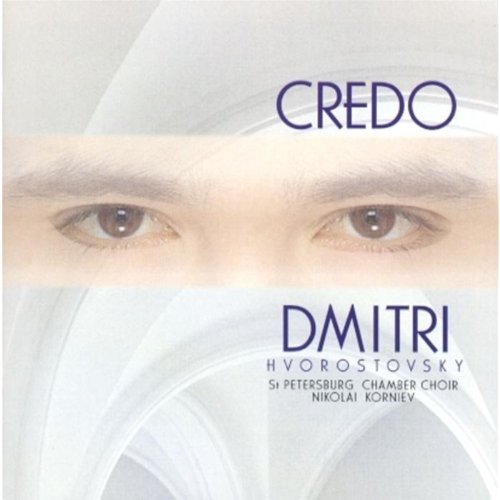Dmitri Hvorostovsky - Credo (1996)

Artist: Dmitri Hvorostovsky, St Petersburg Chamber Choir, Nikolai Korniev
Title: Credo
Year Of Release: 1996
Label: Philips
Genre: Classical
Quality: APE (image + .cue)
Total Time: 63:15 min
Total Size: 194 MB
WebSite: Album Preview
Tracklist:Title: Credo
Year Of Release: 1996
Label: Philips
Genre: Classical
Quality: APE (image + .cue)
Total Time: 63:15 min
Total Size: 194 MB
WebSite: Album Preview
01. Come To Me, All You Who Labour
02. The Good Thief
03. Praise Ye The Name Of The Lord
04. Great Doxology
05. Cheruic Hymn: Cherubic Hymn
06. Symbol Of Faith (Creed)
07. Our Father
08. Blessed Is The Man
09. From My Youth
10. Let My Prayer
11. Gabriel Appeared
12. Strengthen, O Lord
13. We Praise Thee
Don’t be put off by the cover, showing Hvorostovsky’s eyes overlaid on some ecclesiastical vaulting: this is an impressive anthology in many ways, containing some unusual music and demonstrating a close collaboration between choir and soloist. Inevitably in this repertoire, Hvorostovsky does not, for the most part, have tremendously virtuosic writing to deal with. Instead he is called upon to sing convincingly and sincerely without being sentimental, and he achieves this very well indeed. Listen, for example, to the choir’s shimmering stillness of Tolstyakov’s Come to me, all you who labour (track 1) in the midst of which Hvorostovsky’s radiant, rich entry marks the beginning of a beautifully shaped line. Burmagin’s otherwise unimpressive The good thief (track 2) offers the soloist the opportunity to use his silvery upper register, and he is even more impressive in the third track, Khristov’s Praise ye, which effectively places choir and soloist in exultant dialogue.
The two pieces by Sakhnovsky (without soloist) are a real discovery, as hardly any of his music is published. The Cherubic Hymn shows a very imaginative use of choral divisi and its essentially modal language is made piquant by the use of unexpected diatonic dissonances. In the Lord’s Prayer the sopranos’ vibrato is at times somewhat intrusive. The series of pieces by Chesnokov which follows confirms just what a fine composer he was. These works are tremendously resourceful and extremely well performed. Choir and soloist achieve a magical pianissimo in track 10, Let my prayer, and there is also superb control in the final We praise Thee. In Blessed is the Man (track 8), however, I feel that the choir is not present enough and that too much prominence is accorded the soloist; for an alternative approach, listen to Grindenko’s male voice version on Opus 111. A fine release. -- Gramophone (10/1997)
The two pieces by Sakhnovsky (without soloist) are a real discovery, as hardly any of his music is published. The Cherubic Hymn shows a very imaginative use of choral divisi and its essentially modal language is made piquant by the use of unexpected diatonic dissonances. In the Lord’s Prayer the sopranos’ vibrato is at times somewhat intrusive. The series of pieces by Chesnokov which follows confirms just what a fine composer he was. These works are tremendously resourceful and extremely well performed. Choir and soloist achieve a magical pianissimo in track 10, Let my prayer, and there is also superb control in the final We praise Thee. In Blessed is the Man (track 8), however, I feel that the choir is not present enough and that too much prominence is accorded the soloist; for an alternative approach, listen to Grindenko’s male voice version on Opus 111. A fine release. -- Gramophone (10/1997)



![Club Bolero, Armik - A Day in Brazil (2007) [Hi-Res] Club Bolero, Armik - A Day in Brazil (2007) [Hi-Res]](https://img.israbox.com/img/2025-12/15/5l607nskcv4xb0n237d8ngs7q.jpg)




![Sam Most - But Beautiful (2025) [Hi-Res] Sam Most - But Beautiful (2025) [Hi-Res]](https://img.israbox.com/img/2025-12/12/n19esmi2zxvr716zw8citn0dv.jpg)